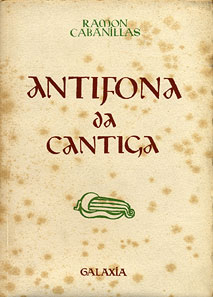Galicia received its name from the Romans, who conquered this area after two fierce campaigns, in 137 BC under Decimus Junius Brutus and in 26-19 BC under Augustus. Until this time the north-west of the Iberian peninsula had been occupied by separate tribes living in castros or hill-forts. The Romans, spurred by the idea of expansion and also by the lucrative gold mines, reorganized the area, drawing people away from their round huts or homes into square Roman towns with a grid-like structure. Latin was the language of the empire and the first example of this in Galicia, the Carbedo tabula hospitalis, is a bronze tablet recording a pact in 28 AD between a local tribe and Roman administrators. In 293 Diocletian divided the Iberian peninsula into five provinces, Gallaecia in the north-west being named after the Callaicus tribe in the Douro valley and covering a much larger area than modern Galicia.
When the Western Empire began to crumble, Germanic tribes moved south. The Swabians arrived in Galicia in 409 and were followed by the Visigoths in 585. In 711 Arab armies invaded the peninsula from Africa, reaching as far as Poitiers and sacking Santiago de Compostela (or at least removing the cathedral bells) under Almanzor in 997.

In the meantime, a very important event had taken place: the alleged discovery of the tomb of St James the Apostle, whose body is said to have been removed from Judaea by two of his disciples and brought in a stone boat to Iria Flavia (south of Santiago) and later buried in a grove with the help of the local queen, Lupa. This burial site was discovered by a 9th-century hermit by the name of Paio, who reported his find to Teodomiro, Bishop of Iria Flavia. Under the patronage of Alfonso II of Asturias, a succession of churches and monasteries soon sprang up over and around the tomb, first among them Santiago Cathedral with its famous Portico of Glory built by Master Matthew in the 12th century and covered by a baroque façade (built by Fernando de Casas Novoa) in the 18th.
Pilgrims soon began to arrive. The first from across the Pyrenees was reputedly Godescalc, Bishop of Le Puy-en-Velay, in 951. We are approaching the beginnings of Galician literature, which at the time was written in Galician-Portuguese (Portugal did not become an independent state until 1139), because the Road to Santiago brought not only pilgrims, but trade and culture, including Provençal courtly love-songs. These were imitated and developed in Galician-Portuguese, which was the language of poetry throughout most of the peninsula. This meant the Portuguese and Castilian kings Dinis and Alfonso X both wrote their poetry in Galician-Portuguese. This lyric poetry was preserved in three cancioneiros or songbooks and included love poems, satirical poems and poems of devotion to the Virgin Mary. The love poems were not only composed by troubadours in honour of their beloved (the cantigas de amor or songs of love), they were written by men from the point of view of women (the cantigas de amigo or songs of a friend). The satirical poems are divided into cantigas de escarnio or songs of mockery and cantigas de maldicir or songs of vilification, but it is the songs of a friend which are considered this period’s highest achievement together with the cantigas de Santa María or songs of Holy Mary attributed to Alfonso X.

With Portuguese independence and the purging of the local nobility in the 14th and 15th centuries, Galician literature fell into decline. Galician continued to be spoken by the vast majority of the population, but very little was written down or published and for this reason the 16th and 17th are known as the Dark Centuries. The earliest printed Galician text is a sonnet, ‘Respice finem’, part of a volume of poetry put together in 1612 on the death of Margaret of Austria. The first Galician play, Gabriel Feixoo de Araúxo’s Famous Interlude, dates to 1671 and in 1697 Santiago University organized a literary contest in honour of its founder, Alonso de Fonseca, the Fiestas Minervales, for which nine poems were submitted in Galician. But that’s about all. However, it would be wrong to think of this as a dark literary period since a strong vein of popular narrative and poetry continued throughout: verses, tales, legends, ballads. It was this richness the Benedictine monk Martín Sarmiento wanted to document with his Conversation of 24 Galician Rustics in 1746.
The Galician Revival (or Rexurdimento) would have to wait until the second half of the 19th century. The first Floral Games, another literary contest, were held in Galicia in 1861 and the anthology published the following year included almost a hundred poems in Galician. But the key year was 1863, the date of the first of two books of Galician poetry by Rosalía de Castro, Galician Songs. Her other book, New Leaves, was published in 1880, the same year as Airs of My Land by Manuel Curros Enríquez and Galician Yearnings by Valentín Lamas Carvajal. Lamas Carvajal wrote the first Galician bestseller, The Peasant’s Catechism, and founded the first Galician periodical, the weekly O Tío Marcos da Portela (the name of the narrator in Sarmiento’s Conversation of 24 Galician Rustics) with a circulation which reached 4000. The other key figure in the Galician Revival was Eduardo Pondal, who wrote Lamentations of the Pines and The Eoans as well as the text to Galicia’s anthem, ‘The Pines’.

History again has a role to play at the turn of the 20th century since there was a large Galician emigrant community in Latin America and especially in Cuba which was instrumental in the revival of Galician culture. This role would be repeated at the end of the Spanish Civil War in 1939, when many Galician intellectuals emigrated to Mexico, Uruguay and above all to Buenos Aires. In Galicia itself, local organizations or Brotherhoods of Language were founded which worked tirelessly to promote Galician culture, the first in Coruña in 1916. Their mouthpiece was A Nosa Terra (a newspaper published until 1936 and again from 1977), alongside which a group of intellectuals including Vicente Risco, Ramón Otero Pedrayo and Castelao published a monthly magazine called Nós. The unofficial role of national poet, which had fallen to Curros Enríquez, who died in 1908, passed to Ramón Cabanillas, one of several poets in the pre-war years who took Galician poetry forward, other notable cases being the avant-garde poets Luis Amado Carballo and Manuel Antonio. The famous Spanish poet Federico García Lorca himself tried his hand at Six Galician Poems, published by Editorial Nós in 1935.
The outbreak of the tragic Spanish Civil War in 1936 put paid to any hopes of Galician autonomy under Franco’s dictatorship and many intellectuals emigrated. But 1950 saw the creation in Vigo of Editorial Galaxia, historically Galicia’s most important publishing house, and a succession of literary texts followed. Galaxia – the brainchild of Ramón Otero Pedrayo, Francisco Fernández del Riego, Ramón Piñeiro, Xaime Isla and others – was in many ways a continuation of the work done by the group of intellectuals who published Nós and had great importance in the post-war years and into the years following the restoration of democracy, an importance it shares today with Edicións Xerais, founded in 1979.

In 1981 the Galician Statute of Autonomy was passed into law. After the death of Franco in 1975, this statute declared Galicia to be an autonomous community with its own government and language. Everyone had the right to know and use Galician and Spanish, which became co-official languages in Galicia itself, and no one was to be discriminated against for the language they spoke. Meanwhile the 1983 Linguistic Normalization Law aimed to promote Galician in all public spaces, including the administration, the media and education, where Galician became an obligatory subject at pre-university level. Children were to speak, read and write this language with the same fluency as Spanish and also had the right to receive initial education in their mother tongue (although in 1995 this was revised to the mother tongue of the majority of children). Both laws implied an improvement of the conditions suffered under Franco’s regime, which had tried to curtail the use in Spain of any language but Spanish.
This newly expressed sense of identity allowed cultural initiatives in the language of Galicia to go ahead unhindered and the use of Galician in schools provided new demand for books and material. Starting during the last years of the dictatorship, but now gathering pace, was a series of cultural associations, literary prizes, publishing houses and authors keen to experiment with different genres and to move away from the predominantly social content of much of the literature being written while Franco was alive. We see a proliferation of literary magazines (Festa da palabra silenciada, Luzes de Galiza, Nordés…) and groupings, from the strictly nationalist Cravo fondo (‘Deep Nail’), which included Ramiro Fonte and whose aim was to take poetry to the Galician working classes, to the experimental Rompente (‘Breaker’) with poets like Alfonso Pexegueiro and Antón Reixa (who in 1985 published his influential History of Rock and Roll) and the Coruña-based De amor e desamor (‘Of Love and Unlove’), which gathered the poets Miguel Anxo Fernán Vello, Xulio López Valcárcel, Pilar Pallarés, Lois Pereiro, Manuel Rivas and Xavier Seoane among others.
In the field of narrative, authors were encouraged to try their hand at a wide range of modalities, from the western (Xosé Fernández Ferreiro’s The Death of Frank González) to science fiction (the same author’s Cosmic Report), from crime (Carlos Reigosa’s Crime in Compostela) to eros (two volumes of his and hers Erotic Stories), from the Arthurian legend (Darío Xohán Cabana’s Gawain in Saor, the first modern Galician bestseller) to history (Víctor Freixanes’ emblematic The Triangle Inscribed in the Circumference), from the Spanish Civil War (a common theme in the work of authors like Xavier Alcalá, Manuel Rivas and Antón Riveiro Coello) to war in general (and the touching war reports turned fiction of Miguel-Anxo Murado writing of his experiences first in Yugoslavia and then in Palestine), from fantasy (Alfredo Conde’s The Griffon) to the experimental work of Suso de Toro, Cid Cabido, Bieito Iglesias and Xavier Queipo, from the conceptual Xosé Carlos Caneiro’s The Misfortune of Solitude to the postmodern Xurxo Borrazás’ I Is. Certain books are held in the memory: Anxo Rei Ballesteros’ Of the Angels and the Dead (1977), Xavier Alcalá’s Our Ashes (1980), The Triangle Inscribed in the Circumference (1982), The Griffon and Crime in Compostela (1984), Gawain in Saor (1989)… The titles themselves point to a period of intense creativity and fresh confidence, which saw the republishing of classic Galician authors such as Álvaro Cunqueiro and Manuel Antonio and, together with the rise of new publishing houses, the translation of foreign books, which always goes to show that a culture is alive. For the first time, the Galician reader had access to a wealth of home-grown novels.

The introduction of literary prizes increased visibility for writers, creating demand and often providing a significant financial award. In the field of fiction, we have the Modesto R. Figueiredo for short stories (organized by the Pedrón de Ouro Foundation since 1975) and, for novels, the Blanco Amor (52 town councils since 1981), Xerais (the publisher since 1984) and García Barros (Estrada Town Council since 1989). In the field of poetry, the Esquío (the Valle-Inclán Cultural Society since 1981), Eusebio Lorenzo Baleirón (Dodro Town Council since 1988), Miguel González Garcés (Coruña Provincial Council since 1991), Espiral Maior (the publisher since 1992), Martín Codax (the wine producer with the support of Vigo City Council and three Galician universities between 1992 and 2000) and Novacaixagalicia (the bank and PEN Club of Galicia since 2002). In the field of drama, the Álvaro Cunqueiro (the Galician government since 1988) and Rafael Dieste (Coruña Provincial Council since 1991) and, in the field of the essay, the Ramón Piñeiro (the Galician government and Galaxia since 2001). This list gives some idea of the role of the administration, cultural associations, publishers and private businesses in promoting the production of literature during this period, which sometimes included publication of the winning work. Another good example of this is the Galician Drama School, which awarded a prize for a short piece of theatre and published the winning plays in its series of Notebooks between 1978 and 1994. Similarly the cultural association Abrente organized a drama festival in Ribadavia between 1973 and 1980, which has continued internationally since 1984 and which, together with the Notebooks, allowed a new generation of playwrights to stage their work and receive publication, first among them Manuel Lourenzo, Roberto Vidal Bolaño, Euloxio Ruibal, João Guisam Seixas and Millán Picouto. Later names include Raúl Dans, Xesús Pisón, Rubén Ruibal, Roberto Salgueiro and Inma Souto. Central to theatrical activity in Galicia during these years is the work of Francisco Pillado Mayor, president of the Galician Drama School.
1980 saw the creation of the Galician-Language Writers Association, 1984 the creation of the Galician Drama Centre, which continues to produce plays today. In 1989 the PEN Club of Galicia joined International PEN, whose 1993 congress was held in the Galician capital, Santiago de Compostela.
A feature of this period is the ability of writers to mix genres. Numerous poets turn their hand to fiction (Darío Xohán Cabana, Manuel Forcadela, Ramiro Fonte, Manuel Rivas). Narrators and poets are playwrights (Cid Cabido, Miguel Anxo Fernán Vello, Miguel-Anxo Murado, Anxo Rei Ballesteros). This tendency waned as time went on, but there are still writers today who continue to be successful in more than one genre. Manuel Rivas is the author of an extraordinary play, The Hero, and has published two children’s books. Teresa Moure, as well as a narrator, is a well-known playwright and essayist. For her, language is a tool to change the world. ‘When we change our language, we change our mind, which is a new form of changing the world’ is the central tenet of her essay The Word of Eve’s Daughters. Furthermore we find a wide range of thinkers at work in the creation of essays on subjects as varied as literature and sociolinguistics (Xesús Alonso Montero, Antón Figueroa, Pilar García Negro), politics and economics (Xosé Luís Barreiro Rivas, Xosé Manuel Beiras, Xavier Vence), history (Xosé Ramón Barreiro Fernández, Justo Beramendi, Ramón Villares), theology (Xosé Chao Rego, Victorino Pérez Prieto, Andrés Torres Queiruga), philosophy (María Xosé Agra, Antón Baamonde, Francisco Sampedro), anthropology (Marcial Gondar, Xosé Manuel González Reboredo, Xosé Ramón Mariño Ferro) and feminism (María Xosé Queizán, Carmen Blanco).
The 1990s saw some innovative fiction produced by writers such as Manuel Rivas (Vermeer’s Milkmaid and Other Stories, which won the 1996 Spanish National Book Award for Fiction, and The Carpenter’s Pencil, the most widely translated work of Galician literature), Suso de Toro (whose novel Tick-Tock was described by the eminent critic and translator Basilio Losada as ‘possibly the most impressive ever written in our language’), Fran Alonso (whose urban themes are found in novels like Trailer), Xosé Miranda (whose Morning Star is among the best-selling titles of modern Galician literature), Cid Cabido (whose abelian group echoes the demands of civil protest movements), Anxo Angueira (whose Listing Ship depicts rural resistance) and others. It is remarkable how many of these authors are involved in the world of journalism (Manuel Rivas started as a journalist and poet), which clearly feeds into their work.

With the introduction of Galician into the curriculum, we have a new generation of writers who have received a formal training in their own language and take on board new concerns (anti-militarism, ecology, feminism) while experimenting with a more direct contact with the reader, form, mundane themes, sexuality. Like Cravo fondo before them, they wish to reach a wider audience. There is also a perceived geographical shift away from the cities of Coruña and Vigo to Santiago, which witnesses the creation of new groups like Redes escarlata (‘Scarlet Nets’) with poets such as Xabier Cordal, Antón Lopo and Oriana Méndez. Groups outside Santiago include Batallón Literario da Costa de Morte (‘Death Coast Literary Battalion’) with poets like Estevo Creus, María Lado and Miro and Rafa Villar. Galician poetry was redefined at the turn of the century with the publication of m-Talá by Chus Pato in much the same way as there had been a shift away from social content in poetry a quarter of a century earlier with the publication of With Gunpowder and Magnolias by Xosé Luís Méndez Ferrín.
The following decade sees a flourishing of women writers, notably in the field of fiction with six of the eleven most recent winners of the Xerais being women: Marilar Aleixandre, Inma López Silva, Teresa Moure, Rexina Vega, Rosa Aneiros and Iolanda Zúñiga. Two books that had a profound influence were Anxos Sumai’s fictional diary Guardian Angels and María Reimóndez’s novel The Knitting Club, later a film.
Special mention must be made of the extraordinary success of writers –and illustrators – of young adult and children’s literature. Of the ten Galician writers who have won the Spanish National Book Award to date, four have been children’s authors: Paco Martín, Xabier P. DoCampo, Fina Casalderrey and Agustín Fernández Paz. But it is not only the enduring charm of adventure stories or rites of passage that ensures their success, it is the quality of illustrations by artists like Xan López Domínguez and Miguelanxo Prado. This success has been accompanied by the notable rise of writers such as Marcos Calveiro (The Painter with the Mallow Hat), Francisco Castro (Call Me Sinbad) and Xosé Neira Cruz (The Stoat Sleeps), who write for adults and children.
Jonathan Dunne, August 2012

